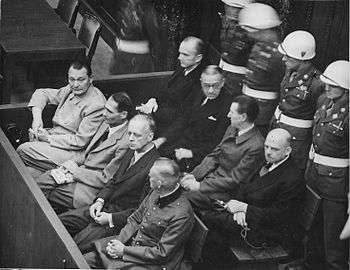Nuremberg trials
| Part of a series on | ||||||||||
| The Holocaust | ||||||||||
|---|---|---|---|---|---|---|---|---|---|---|
 | ||||||||||
|
||||||||||
|
Atrocities |
||||||||||
|
Camps
|
||||||||||
|
Lists Deportations of French Jews
to death camps |
||||||||||
|
Remembrance |
||||||||||
Coordinates: 49°27.2603′N 11°02.9103′E / 49.4543383°N 11.0485050°E The Nuremberg trials (German: die Nürnberger Prozesse) were a series of military tribunals, held by the Allied forces after World War II, which were most notable for the prosecution of prominent members of the political, military, judicial and economic leadership of Nazi Germany who planned, carried out, or otherwise participated in The Holocaust and other war crimes. The trials were held in the city of Nuremberg, Germany.
The first, and best known of these trials, described as "the greatest trial in history" by Norman Birkett, one of the British judges who presided over it,[1] was the trial of the major war criminals before the International Military Tribunal (IMT). Held between 20 November 1945 and 1 October 1946,[2] the Tribunal was given the task of trying 24 of the most important political and military leaders of the Third Reich – though the proceedings of Martin Bormann was tried in absentia, while another, Robert Ley, committed suicide within a week of the trial's commencement.
Not included were Adolf Hitler, Heinrich Himmler, and Joseph Goebbels, all of whom had committed suicide in the spring of 1945, well before the indictment was signed.[3] Reinhard Heydrich was not included, as he had been assassinated in 1942.
The second set of trials of lesser war criminals was conducted under Control Council Law No. 10 at the U.S. Nuremberg Military Tribunals (NMT), which included the Doctors' Trial and the Judges' Trial. This article primarily deals with the IMT; see Subsequent Nuremberg Trials for details on the NMT (the second set of trials).
Origin
There were, I suppose, three possible courses: to let the atrocities which had been committed go unpunished; to put the perpetrators to death or punish them by executive action; or to try them. Which was it to be? Was it possible to let such atrocities go unpunished? Could France, could Russia, could Holland, Belgium, Norway, Czechoslovakia, Poland or Yugoslavia be expected to consent to such a course? ... It will be remembered that after the first world war alleged criminals were handed over to be tried by Germany, and what a farce that was! The majority got off and such sentences as were inflicted were derisory and were soon remitted.[4]
—Geoffrey Lawrence
5 December 1946
A precedent for trying those accused of war crimes had been set at the end of World War I in the Leipzig War Crimes Trials held in May to July 1921 before the Reichsgericht (German Supreme Court) in Leipzig, although these had been on a very limited scale and largely regarded as ineffectual. At the beginning of 1940, the Polish government-in-exile asked the British and French governments to condemn the German invasion of their country. The British initially declined to do so; however, in April 1940, a joint declaration was issued by the British, French and Polish. Relatively bland because of Anglo-French reservations, it proclaimed the trio's "desire to make a formal and public protest to the conscience of the world against the action of the German government whom they must hold responsible for these crimes which cannot remain unpunished."[5]
Three-and-a-half years later, the stated intention to punish the Germans was much more trenchant. On 1 November 1943, the Soviet Union, the United Kingdom and the United States published their "Declaration on German Atrocities in Occupied Europe", which gave a "full warning" that, when the Nazis were defeated, the Allies would "pursue them to the uttermost ends of the earth ... in order that justice may be done. ... The above declaration is without prejudice to the case of the major war criminals whose offences have no particular geographical location and who will be punished by a joint decision of the Government of the Allies."[6] This intention by the Allies to dispense justice was reiterated at the Yalta Conference and at Berlin in 1945.[7]
British War Cabinet documents, released on 2 January 2006, showed that as early as December 1944 the Cabinet had discussed their policy for the punishment of the leading Nazis if captured. The British Prime Minister, Winston Churchill, had then advocated a policy of summary execution in some circumstances, with the use of an Act of Attainder to circumvent legal obstacles, being dissuaded from this only by talks with US and Soviet leaders later in the war.[8]
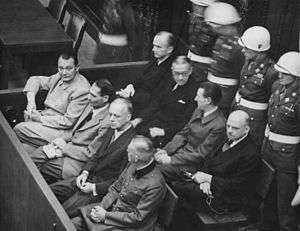
In late 1943, during the Tripartite Dinner Meeting at the Tehran Conference, the Soviet leader, Joseph Stalin, proposed executing 50,000–100,000 German staff officers. US President Franklin D. Roosevelt joked that perhaps 49,000 would do. Churchill, believing them to be serious, denounced the idea of "the cold blooded execution of soldiers who fought for their country" and that he would rather be "taken out in the courtyard and shot" himself than partake in any such action.[9] However, he also stated that war criminals must pay for their crimes and that, in accordance with the Moscow Document which he himself had written, they should be tried at the places where the crimes were committed. Churchill was vigorously opposed to executions "for political purposes."[10][11] According to the minutes of a meeting between Roosevelt and Stalin at Yalta, on 4 February 1945, at the Livadia Palace, President Roosevelt "said that he had been very much struck by the extent of German destruction in the Crimea and therefore he was more bloodthirsty in regard to the Germans than he had been a year ago, and he hoped that Marshal Stalin would again propose a toast to the execution of 50,000 officers of the German Army."[12]
Henry Morgenthau, Jr., US Secretary of the Treasury, suggested a plan for the total denazification of Germany;[13] this was known as the Morgenthau Plan. The plan advocated the forced de-industrialisation of Germany and the summary execution of so-called "arch-criminals", i.e. the major war criminals.[14] Roosevelt initially supported this plan, and managed to convince Churchill to support it in a less drastic form. Later, details were leaked to the public, generating widespread protest. Roosevelt, aware of strong public disapproval, abandoned the plan, but did not adopt an alternative position on the matter. The demise of the Morgenthau Plan created the need for an alternative method of dealing with the Nazi leadership. The plan for the "Trial of European War Criminals" was drafted by Secretary of War Henry L. Stimson and the War Department. Following Roosevelt's death in April 1945, the new president, Harry S. Truman, gave strong approval for a judicial process. After a series of negotiations between Britain, the US, Soviet Union and France, details of the trial were worked out. The trials were to commence on 20 November 1945, in the Bavarian city of Nuremberg.
Creation of the courts
On 20 April 1942, representatives from the nine countries occupied by Germany met in London to draft the "Inter-Allied Resolution on German War Crimes". At the meetings in Tehran (1943), Yalta (1945) and Potsdam (1945), the three major wartime powers, the United Kingdom, United States, and the Soviet Union, agreed on the format of punishment for those responsible for war crimes during World War II. France was also awarded a place on the tribunal. The legal basis for the trial was established by the London Charter, which was agreed upon by the four so-called Great Powers on 8 August 1945, [15] and which restricted the trial to "punishment of the major war criminals of the European Axis countries"
Some 200 German war crimes defendants were tried at Nuremberg, and 1,600 others were tried under the traditional channels of military justice. The legal basis for the jurisdiction of the court was that defined by the Instrument of Surrender of Germany. Political authority for Germany had been transferred to the Allied Control Council which, having sovereign power over Germany, could choose to punish violations of international law and the laws of war. Because the court was limited to violations of the laws of war, it did not have jurisdiction over crimes that took place before the outbreak of war on 1 September 1939.
Location

Leipzig and Luxembourg were briefly considered as the location for the trial.[16] The Soviet Union had wanted the trials to take place in Berlin, as the capital city of the 'fascist conspirators',[16] but Nuremberg was chosen as the site for two reasons, with the first one having been the decisive factor:[17]
- The Palace of Justice was spacious and largely undamaged (one of the few buildings that had remained largely intact through extensive Allied bombing of Germany), and a large prison was also part of the complex.
- Nuremberg was considered the ceremonial birthplace of the Nazi Party. It had hosted the Party's annual propaganda rallies[16] and the Reichstag session that passed the Nuremberg Laws.[17] Thus it was considered a fitting place to mark the Party's symbolic demise.
As a compromise with the Soviets, it was agreed that while the location of the trial would be Nuremberg, Berlin would be the official home of the Tribunal authorities.[18][19][20] It was also agreed that France would become the permanent seat of the IMT[21] and that the first trial (several were planned) would take place in Nuremberg.[18][20]
Most of the accused had previously been detained at Camp Ashcan, a processing station and interrogation center in Luxembourg, and were moved to Nuremberg for the trial.
Participants
Each of the four countries provided one judge and an alternative, as well as a prosecutor.
Judges

-
 Major General Iona Nikitchenko (Soviet main)
Major General Iona Nikitchenko (Soviet main) -
 Lieutenant Colonel Alexander Volchkov (Soviet alternative)
Lieutenant Colonel Alexander Volchkov (Soviet alternative) -
 Lord Justice Colonel Sir Geoffrey Lawrence (British main), President of the Tribunal
Lord Justice Colonel Sir Geoffrey Lawrence (British main), President of the Tribunal -
 Sir Norman Birkett (British alternative)
Sir Norman Birkett (British alternative) -
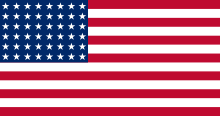 Francis Biddle (American main)
Francis Biddle (American main) -
 John J. Parker (American alternative)
John J. Parker (American alternative) -
 Professor Henri Donnedieu de Vabres (French main)
Professor Henri Donnedieu de Vabres (French main) -
 Robert Falco (French alternative)
Robert Falco (French alternative)
Chief prosecutors
-
 Attorney General Sir Hartley Shawcross (United Kingdom)
Attorney General Sir Hartley Shawcross (United Kingdom) -
 Supreme Court Justice Robert H. Jackson (United States)
Supreme Court Justice Robert H. Jackson (United States) -
 Lieutenant-General Roman Andreyevich Rudenko (Soviet Union)
Lieutenant-General Roman Andreyevich Rudenko (Soviet Union) -
 François de Menthon, later replaced by Auguste Champetier de Ribes (France)
François de Menthon, later replaced by Auguste Champetier de Ribes (France)
Assisting Jackson were the lawyers Telford Taylor, William S. Kaplan[22] and Thomas J. Dodd, and Richard Sonnenfeldt, a US Army interpreter. Assisting Shawcross were Major Sir David Maxwell-Fyfe and Sir John Wheeler-Bennett. Mervyn Griffith-Jones, who was later to become famous as the chief prosecutor in the Lady Chatterley's Lover obscenity trial, was also on Shawcross's team. Shawcross also recruited a young barrister, Anthony Marreco, who was the son of a friend of his, to help the British team with the heavy workload.
Defense counsel
The vast majority of the defense attorneys were German lawyers.[23] These included Georg Fröschmann, Heinz Fritz (Hans Fritzsche), Otto Kranzbühler (Karl Dönitz), Otto Pannenbecker (Wilhelm Frick), Alfred Thoma (Alfred Rosenberg), Kurt Kauffmann (Ernst Kaltenbrunner), Hans Laternser (general staff and high command), Franz Exner (Alfred Jodl), Alfred Seidl (Hans Frank), Otto Stahmer (Hermann Göring), Walter Ballas (Gustav Krupp von Bohlen und Halbach), Hans Flächsner (Albert Speer), Günther von Rohrscheidt (Rudolf Heß), Egon Kubuschok (Franz von Papen), Robert Servatius (Fritz Sauckel), Fritz Sauter (Joachim von Ribbentrop), Walther Funk (Baldur von Schirach), Hanns Marx (Julius Streicher), Otto Nelte (Wilhelm Keitel), and Herbert Kraus / Rudolph Dix (both working for Hjalmar Schacht). The main counsels were supported by a total of 70 assistants, clerks and lawyers.[24] The defense counsel witnesses included several men who took part in the war crimes during World War II, such as Rudolf Höss. The men testifying for the defense hoped to receive more lenient sentences. All of the men testifying on behalf of the defense were found guilty on several counts.[25]
Trial
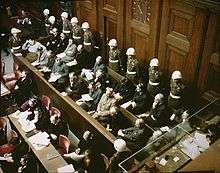
The International Military Tribunal was opened on 19 November 1945 in the Palace of Justice in Nuremberg.[26][27] The first session was presided over by the Soviet judge, Nikitchenko. The prosecution entered indictments against 24 major war criminals and seven organizations – the leadership of the Nazi party, the Reich Cabinet, the Schutzstaffel (SS), Sicherheitsdienst (SD), the Gestapo, the Sturmabteilung (SA) and the "General Staff and High Command", comprising several categories of senior military officers.[avalon 1] These organizations were to be declared "criminal" if found guilty.
The indictments were for:
- Participation in a common plan or conspiracy for the accomplishment of a crime against peace
- Planning, initiating and waging wars of aggression and other crimes against peace
- War crimes
- Crimes against humanity
The 24 accused were, with respect to each charge, either indicted but not convicted (I), indicted and found guilty (G), or not charged (—), as listed below by defendant, charge, and eventual outcome:
| Photos | Name | Count | Penalty | Notes | |||
|---|---|---|---|---|---|---|---|
| 1 | 2 | 3 | 4 | ||||
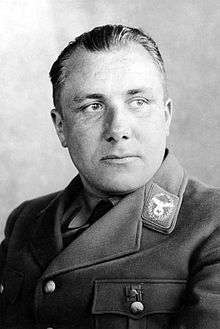 |
Martin Bormann | I | — | G | G | Death | Successor to Hess as Nazi Party Secretary. Sentenced to death in absentia.[avalon 2] Remains found in Berlin in 1972 and eventually dated to 2 May 1945 (per Artur Axmann's account); thought to have been killed trying to flee Berlin in the last few days of the war. |
_A14899.jpg) |
Karl Dönitz | I | G | G | — | 10 years | Leader of the Kriegsmarine from 1943, succeeded Raeder. Initiator of the U-boat campaign. Briefly became President of Germany following Hitler's death.[avalon 3] Convicted of carrying out unrestricted submarine warfare in breach of the 1936 Second London Naval Treaty, but was not punished for that charge because the United States committed the same breach.[28] Released 1 October 1956. Died 24 December 1980. Defense attorney: Otto Kranzbühler |
 |
Hans Frank | I | — | G | G | Death | Reich Law Leader 1933–45 and Governor-General of the General Government in occupied Poland 1939–45. Expressed repentance.[avalon 4] Hanged 16 October 1946. |
 |
Wilhelm Frick | I | G | G | G | Death | Hitler's Minister of the Interior 1933–43 and Reich Protector of Bohemia-Moravia 1943–45. Co-authored the Nuremberg Race Laws.[avalon 5] Hanged 16 October 1946. |
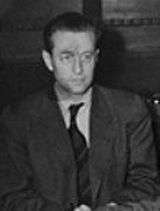 |
Hans Fritzsche | I | I | I | — | Acquitted | Popular radio commentator; head of the news division of the Nazi Propaganda Ministry.[avalon 6] Released early in 1950.[29] Fritzsche had made himself a career within German radio, because his voice was similar to Goebbels's.[30] Died 27 September 1953. |
 |
Walther Funk | I | G | G | G | Life imprisonment |
Hitler's Minister of Economics; succeeded Schacht as head of the Reichsbank. Released because of ill health on 16 May 1957.[avalon 7] Died 31 May 1960. |
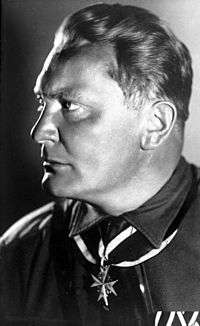 |
Hermann Göring | G | G | G | G | Death | Reichsmarschall, Commander of the Luftwaffe 1935–45, Chief of the 4-Year Plan 1936–45, and original head of the Gestapo before turning it over to the SS in April 1934. Originally the second-highest-ranked member of the Nazi Party and Hitler's designated successor, he fell out of favor with Hitler in April 1945. Highest ranking Nazi official to be tried at Nuremberg. [31] Committed suicide the night before his execution.[avalon 8] |
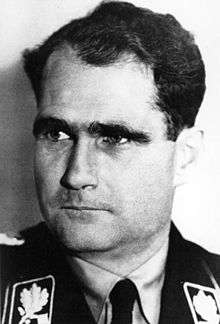 |
Rudolf Hess | G | G | I | I | Life imprisonment |
Hitler's Deputy Führer until he flew to Scotland in 1941 in an attempt to broker peace with the United Kingdom. Had been imprisoned since then. After trial, incarcerated at Spandau Prison where he committed suicide in 1987.[avalon 9] |
 |
Alfred Jodl | G | G | G | G | Death | Wehrmacht Generaloberst, Keitel's subordinate and Chief of the OKW's Operations Division 1938–45. Signed orders for the summary execution of Allied commandos and Soviet commissars [avalon 10] Signed the instruments of surrender on 7 May 1945 in Reims as the representative of Karl Dönitz. Hanged 16 October 1946. Posthumously rehabilitated in 1953, which was later reversed. |
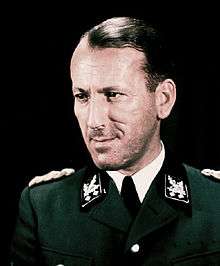 |
Ernst Kaltenbrunner | I | — | G | G | Death | Highest-ranking SS leader to be tried at Nuremberg. Chief of RSHA 1943–45, the Nazi organ comprising the intelligence service (SD), Secret State Police (Gestapo) and Criminal Police (Kripo) and having overall command over the Einsatzgruppen.[avalon 11] Hanged 16 October 1946. |
 |
Wilhelm Keitel | G | G | G | G | Death | Head of Oberkommando der Wehrmacht (OKW) and de facto defence minister 1938–45. Known for his unquestioning loyalty to Hitler.[32] Signed numerous orders calling for soldiers and political prisoners to be executed. Expressed repentance.[avalon 12] Hanged 16 October 1946. |
 |
Gustav Krupp von Bohlen und Halbach | I | I | I | — | Major industrialist. C.E.O. of Friedrich Krupp AG 1912–45. Medically unfit for trial; he had been partially paralyzed since 1941. Due to an error, Gustav, instead of his son Alfried (who ran Krupp for his father during most of the war), was selected for indictment.[33] The prosecutors attempted to substitute his son in the indictment, but the judges rejected this due to proximity to trial. However, the charges against him remained on record in the event he should recover (he died in February 1950).[34] Alfried was tried in a separate Nuremberg trial (the Krupp Trial) for the use of slave labour, thereby escaping worse charges and possible execution. | |
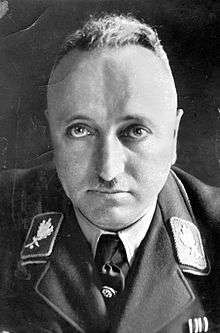 |
Robert Ley | I | I | I | I | — | Head of DAF, German Labour Front. Committed suicide on 25 October 1945, before the trial began. Indicted but neither acquitted nor found guilty as trial did not proceed. |
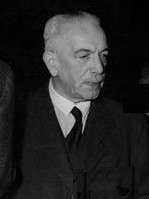 |
Baron Konstantin von Neurath | G | G | G | G | 15 years | Minister of Foreign Affairs 1932–38, succeeded by Ribbentrop. Later, Protector of Bohemia and Moravia 1939–43. On furlough since 1941, he resigned in 1943 because of a dispute with Hitler. Released (ill health) 6 November 1954[avalon 13] after suffering a heart attack. Died 14 August 1956. |
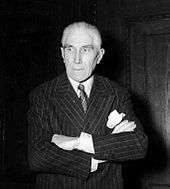 |
Franz von Papen | I | I | — | — | Acquitted | Chancellor of Germany in 1932 and Vice-Chancellor under Hitler in 1933–34. Ambassador to Austria 1934–38 and ambassador to Turkey 1939–44. Although acquitted at Nuremberg, von Papen was reclassified as a war criminal in 1947 by a German de-Nazification court, and sentenced to eight years' hard labour. He was acquitted following appeal after serving two years.[avalon 14] |
 |
Erich Raeder | G | G | G | — | Life imprisonment | Commander In Chief of the Kriegsmarine from 1928 until his retirement in 1943, succeeded by Dönitz. Released (ill health) 26 September 1955.[avalon 15] Died 6 November 1960. |
 |
Joachim von Ribbentrop | G | G | G | G | Death | Ambassador-Plenipotentiary 1935–36. Ambassador to the United Kingdom 1936–38. Minister of Foreign Affairs 1938–45.[avalon 16] Hanged 16 October 1946. |
 |
Alfred Rosenberg | G | G | G | G | Death | Racial theory ideologist. Later, Minister of the Eastern Occupied Territories 1941–45.[avalon 17] Hanged 16 October 1946. |
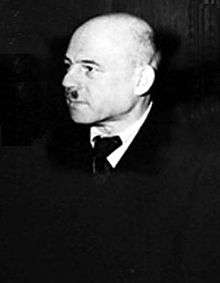 |
Fritz Sauckel | I | I | G | G | Death | Gauleiter of Thuringia 1927–45. Plenipotentiary of the Nazi slave labor program 1942–45.[avalon 18] Hanged 16 October 1946. Defense attorney: Robert Servatius |
 |
Dr. Hjalmar Schacht | I | I | — | — | Acquitted | Prominent banker and economist. Pre-war president of the Reichsbank 1923–30 & 1933–38 and Economics Minister 1934–37. Admitted to violating the Treaty of Versailles.[avalon 19] Many at Nuremberg alleged that the British had brought about Schacht's acquittal to safeguard German industrialists and financiers; Francis Biddle revealed Geoffrey Lawrence had argued that Schacht, being a "man of character", was nothing like the other "ruffians" on trial.[35] By 1944, he had been imprisoned in a concentration camp by the Nazis, and was outraged to be put on trial as a major war criminal.[36] |
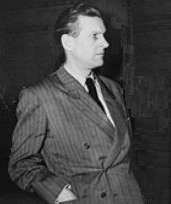 |
Baldur von Schirach | I | — | — | G | 20 years | Head of the Hitlerjugend from 1933–40, Gauleiter of Vienna 1940–45. Expressed repentance.[avalon 20] |
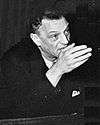 |
Arthur Seyss-Inquart | I | G | G | G | Death | Instrumental in the Anschluss and briefly Austrian Chancellor 1938. Deputy to Frank in Poland 1939–40. Later, Reichskommissar of the occupied Netherlands 1940–45. Expressed repentance.[avalon 21] Hanged 16 October 1946. |
 |
Albert Speer | I | I | G | G | 20 Years | Hitler's friend, favorite architect, and Minister of Armaments from 1942 until the end of the war. In this capacity, he was ultimately responsible for the use of slave labourers from the occupied territories in armaments production. Expressed repentance.[avalon 22] |
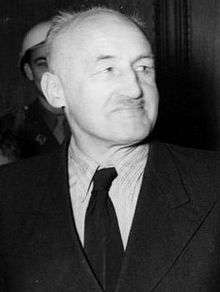 |
Julius Streicher | I | — | — | G | Death | Gauleiter of Franconia 1922–40, when he was relieved of authority but allowed by Hitler to keep his official title. Publisher of the anti-Semitic weekly newspaper Der Stürmer.[avalon 23] Hanged 16 October 1946. |
Intelligence tests and psychiatric assessments
The Rorschach test was administered to the defendants, along with the Thematic Apperception Test and a German adaptation of the Wechsler-Bellevue Intelligence Test.[37] All were above average intelligence, several considerably.[38]
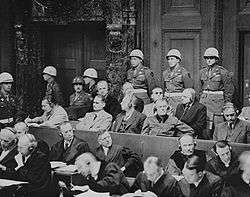
| Name | I.Q.[39][40] |
|---|---|
| Dönitz, Karl | 138 |
| Frank, Hans | 130 |
| Frick, Wilhelm | 124 |
| Fritzsche, Hans | 130 |
| Funk, Walther | 124 |
| Göring, Hermann | 138 |
| Hess, Rudolf | 120 |
| Jodl, Alfred | 127 |
| Kaltenbrunner, Ernst | 113 |
| Keitel, Wilhelm | 129 |
| Neurath, Konstantin von | 125 |
| Papen, Franz von | 134 |
| Raeder, Erich | 134 |
| Ribbentrop, Joachim von | 129 |
| Rosenberg, Alfred | 127 |
| Sauckel, Fritz | 118 |
| Schacht, Hjalmar | 143 |
| Schirach, Baldur von | 130 |
| Seyss-Inquart, Arthur | 141 |
| Speer, Albert | 128 |
| Streicher, Julius | 106 |
Throughout the trials, specifically between January and July 1946, the defendants and a number of witnesses were interviewed by American psychiatrist Leon Goldensohn. His notes detailing the demeanor and comments of the defendants survive; they were edited into book form and published in 2004.[41] Jean Delay was the psychiatric expert for the French delegation in the trial of Rudolph Hess.[42]
Overview of the trial
.jpg)
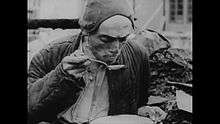

- 20 November 1945: Start of the trials.
- 21 November 1945: Judge Robert H. Jackson opens for the prosecution with a speech lasting several hours, leaving a deep impression on both the court and the public.
- 26 November 1945: The Hossbach Memorandum (of a conference in which Hitler explained his war plans) is presented.
- 29 November 1945: The film "Nazi concentration camps" is screened.
- 30 November 1945: Witness Erwin von Lahousen testifies that Keitel and von Ribbentrop gave orders for the murder of Poles, Jews, and Russian prisoners of war.
- 11 December 1945: The film The Nazi Plan is screened, showing long-term planning and preparations for war by the Nazis.
- 3 January 1946: Witness Otto Ohlendorf, former head of Einsatzgruppe D, detachedly admits to the murder of around 90,000 Jews.
- 3 January 1946: Witness Dieter Wisliceny describes the organisation of RSHA Department IV-B-4, in charge of the Final Solution.
- 7 January 1946: Witness and former SS-Obergruppenführer Erich von dem Bach-Zelewski admits to the organized mass murder of Jews and other groups in the Soviet Union.
- 28 January 1946: Witness Marie-Claude Vaillant-Couturier, member of the French Resistance and concentration camp survivor, testifies on the Holocaust, becoming the first Holocaust survivor to do so.
- 11–12 February 1946: Witness and former Field Marshal Friedrich Paulus, who had been secretly brought to Nuremberg, testifies on the question of waging a war of aggression.
- 14 February 1946: The Soviet prosecutors try to blame the Katyn massacre on the Germans.
- 19 February 1946: The film Cruelties of the German-Fascist Intruders, detailing the atrocities which took place in the extermination camps, is screened.
- 27 February 1946: Witness Abraham Sutzkever testifies on the murder of almost 80,000 Jews in Vilnius by the Germans occupying the city.
- 8 March 1946: The first witness for the defense testifies – former General Karl Bodenschatz.
- 13–22 March 1946: Hermann Göring takes the stand.
- 15 April 1946: Witness Rudolf Höss, former commandant of Auschwitz, confirms that Kaltenbrunner had never been there, but admits to having carried out mass murder.
- 21 May 1946: Witness Ernst von Weizsäcker explains the German-Soviet Non-Aggression Pact of 1939, including its secret protocol detailing the division of Eastern Europe between Germany and the Soviet Union.
- 20 June 1946: Albert Speer takes the stand. He is the only defendant to take personal responsibility for his actions.
- 29 June 1946: The defense for Martin Bormann testifies.
- 1–2 July 1946: The court hears six witnesses testifying on the Katyn massacre; the Soviets fail to pin the blame for the event on Germany.
- 2 July 1946: Admiral Chester W. Nimitz provides written testimony regarding attacks on merchant vessels without warning, admitting that Germany was not alone in these attacks, as the US did the same.
- 4 July 1946: Final statements for the defense.
- 26 July 1946: Final statements for the prosecution.
- 30 July 1946: Start of the trial of the "criminal organizations".
- 31 August 1946: Last statements by the defendants.
- 1 September 1946: The court adjourns.
- 30 September–1 October 1946: The sentencing occurs, taking two days, with the individual sentences read out on the afternoon of 1 October.[43]
The accusers were successful in unveiling the background of developments leading to the outbreak of World War II, which cost at least 40 million lives in Europe alone,[44] as well as the extent of the atrocities committed in the name of the Hitler regime. Twelve of the accused were sentenced to death, seven received prison sentences (ranging from 10 years to life in prison), three were acquitted, and two were not charged.[45]
Executions
The death sentences were carried out on 16 October 1946 by hanging using the standard drop method instead of long drop. The U.S. army denied claims that the drop length was too short which caused the condemned to die slowly from strangulation instead of quickly from a broken neck.[46] But evidence remains that some of the condemned men died agonizingly slowly, struggling for 14 to 28 minutes before finally choking to death.[47][48] The executioner was John C. Woods. Woods had hanged 34 U.S. soldiers during the war, botching several of them.[49] The executions took place in the gymnasium of the court building (demolished in 1983).[50]
Although the rumor has long persisted that the bodies were taken to Dachau and burned there, they were actually incinerated in a crematorium in Munich, and the ashes scattered over the river Isar.[51] The French judges suggested that the military condemned (Göring, Keitel and Jodl) be shot by a firing squad, as is standard for military courts-martial, but this was opposed by Biddle and the Soviet judges, who argued that the military officers had violated their military ethos and were not worthy of death by being shot, which was considered to be more dignified. The prisoners sentenced to incarceration were transferred to Spandau Prison in 1947.
Of the 12 defendants sentenced to death by hanging, two were not hanged: Martin Bormann was convicted in absentia (he had, unknown to the Allies, died while trying to escape from Berlin in May 1945), and Hermann Göring committed suicide the night before the execution. The remaining 10 defendants sentenced to death were hanged.
Nuremberg principles
The definition of what constitutes a war crime is described by the Nuremberg principles, a set of guidelines document which was created as a result of the trial. The medical experiments conducted by German doctors and prosecuted in the so-called Doctors' Trial led to the creation of the Nuremberg Code to control future trials involving human subjects, a set of research ethics principles for human experimentation.
Of the indicted organizations the following were found not to be criminal:
- Reichsregierung
- "The General Staff and High Command" was found not to comprise a group or organization as defined by Article 9 of the London Charter
- Sturmabteilung
Subsidiary and related trials
The American authorities conducted subsequent Nuremberg Trials in their occupied zone.
Other trials conducted after the Nuremberg Trials include the following:
- Auschwitz Trial
- Belsen Trial
- Belzec Trial before the 1st Munich District Court in the mid-1960s, of eight SS-men of the Belzec extermination camp
- Chełmno trials of the Chełmno extermination camp personnel, held in Poland and in Germany. The cases were decided almost twenty years apart
- Dachau Trials
- Frankfurt Auschwitz Trials
- Majdanek trials, the longest Nazi war crimes trial in history, spanning over 30 years
- Mauthausen-Gusen camp trials
- Ravensbrück Trial
- Sobibor trial held in Hagen, Germany in 1965 against the SS-men of the Sobibor extermination camp
- Treblinka trials in Düsseldorf, Germany
American role in the trial
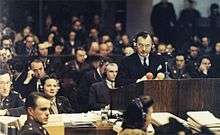
While Sir Geoffrey Lawrence of Britain was the judge chosen as president of the court, the most prominent of the judges at trial arguably was his American counterpart, Francis Biddle.[52] Prior to the trial, Biddle had been Attorney General of the United States but had been asked to resign by Truman earlier in 1945.[53]
Some accounts argue that Truman had appointed Biddle as the main American judge for the trial as an apology for asking for his resignation.[53] Ironically, Biddle was known during his time as Attorney General for opposing the idea of prosecuting Nazi leaders for crimes committed before the beginning of the war, even sending out a memorandum on 5 January 1945 on the subject.[54] The note also expressed Biddle's opinion that instead of proceeding with the original plan for prosecuting entire organizations, there should simply be more trials that would prosecute specific offenders.[54]
Biddle soon changed his mind, as he approved a modified version of the plan on 21 January 1945, likely due to time constraints, since the trial would be one of the main issues discussed at Yalta.[55] At trial, the Nuremberg tribunal ruled that any member of an organization convicted of war crimes, such as the SS or Gestapo, who had joined after 1939 would be considered a war criminal.[56] Biddle managed to convince the other judges to make an exemption for any member who was drafted or had no knowledge of the crimes being committed by these organizations.[53]
Justice Robert H. Jackson played an important role in not only the trial itself, but also in the creation of the International Military Tribunal, as he led the American delegation to London that, in the summer of 1945, argued in favour of prosecuting the Nazi leadership as a criminal conspiracy.[57] According to Airey Neave, Jackson was also the one behind the prosecution's decision to include membership in any of the six criminal organizations in the indictments at the trial, though the IMT rejected this on the grounds that it was wholly without precedent in either international law or the domestic laws of any of the Allies.[58] Jackson also attempted to have Alfried Krupp be tried in place of his father, Gustav, and even suggested that Alfried volunteer to be tried in his father's place.[59] Both proposals were rejected by the IMT, particularly by Lawrence and Biddle, and some sources indicate that this resulted in Jackson being viewed unfavourably by the latter.[59]
Thomas Dodd was a prosecutor for the United States. There was an immense amount of evidence backing the prosecutors' case, especially since meticulous records of the Nazis' actions had been kept. There were records taken in by the prosecutors that had signatures from specific Nazis signing for everything from stationery supplies to Zyklon B gas, which was used to kill the inmates of the deathcamps. Thomas Dodd showed a series of pictures to the courtroom after reading through the documents of crimes committed by the defendants. The showing consisted of pictures displaying the atrocities performed by the defendants. The pictures had been gathered when the inmates were liberated from the concentration camps.[60]
Henry Gerecke, a Lutheran pastor, was sent to minister to the Nazi defendants.[61]
Legacy
The Tribunal is celebrated for establishing that "[c]rimes against international law are committed by men, not by abstract entities, and only by punishing individuals who commit such crimes can the provisions of international law be enforced."[62] The creation of the IMT was followed by trials of lesser Nazi officials and the trials of Nazi doctors, who performed experiments on people in prison camps. It served as the model for the International Military Tribunal for the Far East which tried Japanese officials for crimes against peace and against humanity. It also served as the model for the Eichmann trial and for present-day courts at The Hague, for trying crimes committed during the Balkan wars of the early 1990s, and at Arusha, for trying the people responsible for the genocide in Rwanda.
The Nuremberg trials had a great influence on the development of international criminal law. The Conclusions of the Nuremberg trials served as models for:
- The Genocide Convention, 1948.
- The Universal Declaration of Human Rights, 1948.
- The Nuremberg Principles, 1950.
- The Convention on the Abolition of the Statute of Limitations on War Crimes and Crimes against Humanity, 1968.
- The Geneva Convention on the Laws and Customs of War, 1949; its supplementary protocols, 1977.
The International Law Commission, acting on the request of the United Nations General Assembly, produced in 1950 the report Principles of International Law Recognized in the Charter of the Nürnberg Tribunal and in the Judgement of the Tribunal (Yearbook of the International Law Commission, 1950, vol. II[63]). See Nuremberg Principles.
The influence of the tribunal can also be seen in the proposals for a permanent international criminal court, and the drafting of international criminal codes, later prepared by the International Law Commission.
Tourists can visit courtroom 600 on days when no trial is on. A permanent exhibition has been dedicated to the trials.[64]
Establishment of a permanent International Criminal Court
The Nuremberg trials initiated a movement for the prompt establishment of a permanent international criminal court, eventually leading over fifty years later to the adoption of the Statute of the International Criminal Court. This movement was brought about because during the trials, there were conflicting court methods between the German court system and the U.S. court system. The crime of conspiracy was unheard of in the civil law systems of the Continent. Therefore, the German defense found it unfair to charge the defendants with conspiracy to commit crimes, while the judges from common-law countries were used to doing so.[65]
"It [IMT] was the first successful international criminal court, and has since played a pivotal role in the development of international criminal law and international institutions” (Fichtelberg 5).
Criticism
You'll see. A few years from now the lawyers of the world will condemn this trial. You can't have a trial without law.[66]
—Joachim von Ribbentrop
20 November 1945
Critics of the Nuremberg trials argued that the charges against the defendants were only defined as "crimes" after they were committed and that therefore the trial was invalid as a form of "victors' justice".[67][68] The alleged double standards associated with putative victor's justice are also evident from the indictment of German defendants for conspiracy to commit aggression against Poland in 1939, while no one from the Soviet Union was charged for being part of the same conspiracy. As Biddiss observed, "the Nuremberg Trial continues to haunt us. ... It is a question also of the weaknesses and strengths of the proceedings themselves."[69][70][71]
Quincy Wright, writing eighteen months after the conclusion of the IMT, explained the opposition to the Tribunal thus:
The assumptions underlying the Charter of the United Nations, the Statute of the International Court of Justice, and the Charter of the Nuremberg Tribunal are far removed from the positivistic assumptions which greatly influenced the thought of international jurists in the nineteenth century. Consequently, the activities of those institutions have frequently been vigorously criticized by positivistic jurists ... [who] have asked: How can principles enunciated by the Nuremberg Tribunal, to take it as an example, be of legal value until most of the states have agreed to a tribunal with jurisdiction to enforce those principles? How could the Nuremberg Tribunal have obtained jurisdiction to find Germany guilty of aggression, when Germany had not consented to the Tribunal? How could the law, first explicitly accepted in the Nuremberg Charter of 1945, have bound the defendants in the trial when they committed the acts for which they were indicted years earlier?[72]
Art.19 "The Tribunal shall not be bound by technical rules of evidence."
Charter of the International Military Tribunal
Art.21 "The Tribunal shall not require proof of facts of common knowledge but shall take judicial notice thereof."
Charter of the International Military Tribunal
Chief Justice of the United States Supreme Court Harlan Fiske Stone called the Nuremberg trials a fraud. "(Chief U.S. prosecutor) Jackson is away conducting his high-grade lynching party in Nuremberg," he wrote. "I don't mind what he does to the Nazis, but I hate to see the pretense that he is running a court and proceeding according to common law. This is a little too sanctimonious a fraud to meet my old-fashioned ideas."[73]
Jackson, in a letter discussing the weaknesses of the trial, in October 1945 told U.S. President Harry S. Truman that the Allies themselves "have done or are doing some of the very things we are prosecuting the Germans for. The French are so violating the Geneva Convention in the treatment of prisoners of war that our command is taking back prisoners sent to them. We are prosecuting plunder and our Allies are practising it. We say aggressive war is a crime and one of our allies asserts sovereignty over the Baltic States based on no title except conquest."[74][75]
Associate Supreme Court Justice William O. Douglas charged that the Allies were guilty of "substituting power for principle" at Nuremberg. "I thought at the time and still think that the Nuremberg trials were unprincipled," he wrote. "Law was created ex post facto to suit the passion and clamor of the time."[76]
U.S. Deputy Chief Counsel Abraham Pomerantz resigned in protest at the low caliber of the judges assigned to try the industrial war criminals such as those at I.G. Farben.[77]
Many Germans who agreed with the idea of punishment for war crimes, admitted trepidation concerning the trials. A contemporary German jurist said:
That the defendants at Nuremberg were held responsible, condemned and punished, will seem to most of us initially as a kind of historical justice. However, no one who takes the question of guilt seriously, above all no responsibly thoughtful jurist, will be content with this sensibility nor should they be allowed to be. Justice is not served when the guilty parties are punished in any old way, even if this seems appropriate with regard to their measure of guilt. Justice is only served when the guilty are punished in a way that carefully and conscientiously considers their criminal errors according to the provisions of valid law under the jurisdiction of a legally appointed judge.[78]
The validity of the court has been questioned on a number of grounds:
- The defendants were not allowed to appeal or affect the selection of judges.
- A. L. Goodhart, Professor at Oxford, opposed the view that, because the judges were appointed by the victors, the Tribunal was not impartial and could not be regarded as a court in the true sense. He wrote: Attractive as this argument may sound in theory, it ignores the fact that it runs counter to the administration of law in every country. If it were true then no spy could be given a legal trial, because his case is always heard by judges representing the enemy country. Yet no one has ever argued that in such cases it was necessary to call on neutral judges. The prisoner has the right to demand that his judges shall be fair, but not that they shall be neutral. As Lord Writ has pointed out, the same principle is applicable to ordinary criminal law because 'a burglar cannot complain that he is being tried by a jury of honest citizens.[79]
- One of the charges, brought against Keitel, Jodl, and Ribbentrop included conspiracy to commit aggression against Poland in 1939. The Secret Protocols of the German-Soviet Non-Aggression Pact of 23 August 1939, proposed the partition of Poland between the Germans and the Soviets (which was subsequently executed in September 1939); however, Soviet leaders were not tried for being part of the same conspiracy.[80] Instead, the Tribunal proclaimed the Secret Protocols of the Non-Aggression Pact to be a forgery. Moreover, Allied Powers Britain and Soviet Union were not tried for preparing and conducting the Anglo-Soviet invasion of Iran and the Winter War, respectively.
- In 1915, the Allied Powers, Britain, France, and Russia, jointly issued a statement explicitly charging, for the first time, another government (the Sublime Porte) of committing "a crime against humanity". However it was not until the phrase was further developed in the London Charter that it had a specific meaning. As the London Charter definition of what constituted a crime against humanity was unknown when many of the crimes were committed, it could be argued to be a retroactive law, in violation of the principles of prohibition of ex post facto laws and the general principle of penal law nullum crimen, nulla poena sine praevia lege poenali.[avalon 24]
- The court agreed to relieve the Soviet leadership from attending these trials as war criminals in order to hide their crimes against war civilians, war crimes that were committed by their army that included "carving up Poland in 1939 and attacking Finland three months later." This "exclusion request" was initiated by the Soviets and subsequently approved by the court's administration.[81]
- The trials were conducted under their own rules of evidence. The Charter of the International Military Tribunal permitted the use of normally inadmissible "evidence". Article 19 specified that "The Tribunal shall not be bound by technical rules of evidence ... and shall admit any evidence which it deems to have probative value". Article 21 of the Nuremberg International Military Tribunal (IMT) Charter stipulated:
- The Tribunal shall not require proof of facts of common knowledge but shall take judicial notice thereof. It shall also take judicial notice of official governmental documents and reports of the United [Allied] Nations, including acts and documents of the committees set up in the various allied countries for the investigation of war crimes, and the records and findings of military and other Tribunals of any of the United [Allied] Nations.
- Though the ICTY later held it to be flawed in principle",[82] the tu quoque argument, adduced by German defendants, was admitted as a valid defense during the trials, and the admirals Dönitz and Raeder were not punished for waging unrestricted submarine warfare.[82]
- The chief Soviet prosecutor submitted false documentation in an attempt to indict defendants for the murder of thousands of Polish officers in the Katyn forest near Smolensk. However, the other Allied prosecutors refused to support the indictment and German lawyers promised to mount an embarrassing defense. No one was charged or found guilty at Nuremberg for the Katyn Forest massacre.[83] In 1990, the Soviet government acknowledged that the Katyn massacre was carried out, not by the Germans, but by the Soviet secret police.[84]
- Freda Utley, in her 1949 book "The High Cost of Vengeance"[85] charged the court with amongst other things double standards. She pointed to the Allied use of civilian forced labor, and deliberate starvation of civilians[86][87] in the occupied territories. She also noted that General Rudenko, the chief Soviet prosecutor, after the trials became commandant of the Sachsenhausen concentration camp. (After the fall of East Germany the bodies of 12,500 Soviet era victims were uncovered at the camp, mainly "children, adolescents and elderly people."[88])
- Luise, the wife of Alfred Jodl, attached herself to her husband's defense team. Subsequently, interviewed by Gitta Sereny, researching her biography of Albert Speer, Luise alleged that in many instances the Allied prosecution made charges against Jodl based on documents that they refused to share with the defense. Jodl nevertheless proved some of the charges made against him were untrue, such as the charge that he helped Hitler gain control of Germany in 1933. He was in one instance aided by a GI clerk who chose to give Luise a document showing that the execution of a group of British commandos in Norway had been legitimate. The GI warned Luise that if she didn't copy it immediately she would never see it again.[89]
- The main Soviet judge, Iona Nikitchenko, presided over some of the most notorious of Joseph Stalin's show trials during the Great Purges of 1936 to 1938, where he among other things sentenced Kamenev and Zinoviev.[90] According to the declassified Soviet archives, 681,692 people arrested for "counter-revolutionary and state crimes" were shot in 1937 and 1938 alone–an average of over 900 executions a day.[91]
- The Soviet prosecutor, Roman Rudenko, later became commandant of NKVD special camp Nr. 7.[92] By the time the camp closed in the spring of 1950, at least 12,000 prisoners had died due to the catastrophic prison conditions, hunger and psychological or physical exhaustion.[93]
- The Tribunal itself strongly disputed that the London Charter was ex post facto law, pointing to existing international agreements signed by Germany that made aggressive war and certain wartime actions unlawful, such as the Kellogg-Briand Pact, the Covenant of the League of Nations, and the Hague Conventions.[avalon 25]
In an editorial at the time The Economist, a British weekly newspaper, criticised the hypocrisy of both Britain and France for supporting the expulsion of the Soviet Union from the League of Nations over its unprovoked attack against Finland in 1939 and for six years later cooperating with the USSR as a respected equal at Nuremberg. It also criticised the allies for their own double-standard at the Nuremberg Trials: "nor should the Western world console itself that the Russians alone stand condemned at the bar of the Allies' own justice. ... Among crimes against humanity stands the offence of the indiscriminate bombing of civilian populations. Can the Americans who dropped the atom bomb and the British who destroyed the cities of western Germany plead 'not guilty' on this count? Crimes against humanity also include the mass expulsion of populations. Can the Anglo-Saxon leaders who at Potsdam condoned the expulsion of millions of Germans from their homes hold themselves completely innocent? ... The nations sitting in judgement have so clearly proclaimed themselves exempt from the law which they have administered."[94]
Legitimacy
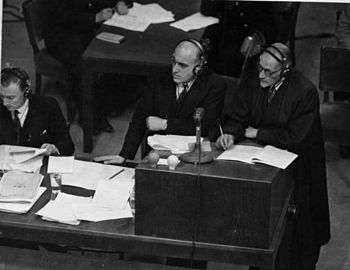
One criticism that was made of the IMT was that some treaties were not binding on the Axis powers because they were not signatories. This was addressed in the judgment relating to war crimes and crimes against humanity,[avalon 26] which contains an expansion of customary law: "the [Hague] Convention expressly stated that it was an attempt 'to revise the general laws and customs of war,' which it thus recognised to be then existing, but by 1939 these rules laid down in the Convention were recognised by all civilised nations, and were regarded as being declaratory of the laws and customs of war which are referred to in Article 6 (b) of the [London] Charter."
Introduction of extempore simultaneous interpretation
The Nuremberg Trials employed four official languages: English, German, French, and Russian. In order to address the complex linguistic issues that clouded over the proceedings, interpretation and translation departments had to be established. However, it was feared that consecutive interpretation would slow down the proceedings significantly. What is therefore unique in both the Nuremberg tribunals and history of the interpretation profession was the introduction of an entirely new technique, extempore simultaneous interpretation. This technique of interpretation requires the interpreter to listen to a speaker in a source (or passive) language and orally translate that speech into another language in real time, that is, simultaneously, through headsets and microphones. Interpreters were split into four sections, one for each official language, with three interpreters per section working from the other three languages into the fourth (their mother tongue). For instance, the English booth consisted of three interpreters, one working from German into English, one working from French, and one from Russian, etc. Defendants who did not speak any of the four official languages were provided with consecutive court interpreters. Some of the languages heard over the course of the proceedings included Yiddish, Hungarian, Czech, Ukrainian, and Polish.
The equipment used to establish this system was provided by IBM, and included an elaborate setup of cables which were hooked up to headsets and single earphones directly from the four interpreting booths (often referred to as "the aquarium"). Four channels existed for each working language, as well as a root channel for the proceedings without interpretation. Switching of channels was controlled by a setup at each table in which the listener merely had to turn a dial in order to switch between languages. People tripping over the floor-laid cables often led to the headsets getting disconnected, with several hours at a time sometimes being taken in order to repair the problem and continue on with the trials.
Interpreters were recruited and examined by the respective countries in which the official languages were spoken: US, UK, France, the Soviet Union, Germany, Switzerland, and Austria, as well as in special cases Belgium and the Netherlands. Many were former translators, army personnel, and linguists, some were experienced consecutive interpreters, others were ordinary individuals and even recent secondary school-graduates who led international lives in multilingual environments. It was, and still is believed, that the qualities that made the best interpreters were not just a perfect understanding of two or more languages, but more importantly a broad sense of culture, encyclopædic knowledge, inquisitiveness, as well as a naturally calm disposition.
With the simultaneous technique being extremely new, interpreters practically trained themselves, but many could not handle the pressure or the psychological strain. Many often had to be replaced, many returned to the translation department, and many left. Serious doubts were given as to whether interpretation provided a fair trial for the defendants, particularly because of fears of mistranslation and errors made on transcripts. The translation department had to also deal with the overwhelming problem of being understaffed and overburdened with an influx of documents that could not be kept up with. More often than not, interpreters were stuck in a session without having proper documents in front of them and were relied upon to do sight translation or double translation of texts, causing further problems and extensive criticism. Other problems that arose included complaints from lawyers and other legal professionals with regard to questioning and cross-examination. Legal professionals were most often appalled at the slower speed at which they had to conduct their task because of the extended time required for interpreters to do an interpretation properly. Also, a number of interpreters were noted for protesting the idea of using vulgar language reflected in the proceeds, especially if it referenced Jews or the conditions of the Nazi concentration camps. Bilingual/trilingual members who attended the trials picked up quickly on this aspect of character and were equally quick to file complaints.
Yet, despite the extensive trial and error, without the interpretation system the trials would not have been possible and in turn revolutionized the way multilingual issues were addressed in tribunals and conferences. A number of the interpreters following the trials were immediately recruited into the newly formed United Nations, while others returned to their ordinary lives, pursued other careers, or worked freelance. Outside the boundaries of the trials, many interpreters continued their positions on weekends interpreting for dinners, private meetings between judges, and excursions between delegates. Others worked as investigators or editors, or aided the translation department when they could, often using it as an opportunity to sharpen their skills and to correct poor interpretations on transcripts before they were available for public record.
For further reference, a book titled The Origins of Simultaneous Interpretation: The Nuremberg Trial, written by interpreter Francesca Gaiba, was published by the University of Ottawa Press in 1998.
Today, all major international organizations, as well as any conference or government that uses more than one official language, uses extempore simultaneous interpretation. Notable bodies include the Parliament of Kosovo with three official languages, the Parliament of Canada with two official languages, the Parliament of South Africa with eleven official languages, the European Union with twenty-four official languages, and the United Nations with six official working languages.
See also
- Nuremberg Trials bibliography
- Command responsibility
- Dora Trial
- Eichmann in Jerusalem
- Einsatzgruppen Trial
- International Military Tribunal for the Far East
- Judgment at Nuremberg (1961 film)
- Nuremberg (2000 film)
- List of Axis personnel indicted for war crimes
- Nuremberg Diary, an account of observations and discussions with the defendants by an American psychiatrist
- Research Materials: Max Planck Society Archive
- Superior orders
- Tokyo War Crimes Tribunal
- Transitional justice
References
Notes
- ↑ Marrus 1997, p. 563.
- ↑ Harris 2006, p. 106.
- ↑ Cooper 2011, p. 38. "On October 6, in Berlin, the Chief Prosecutors signed the momentous Indictment setting forth the charges ... against Hermann Göring and his associates and the six organizations, named as criminal, to which they belonged."
- ↑ Lawrence 1947, pp. 152–3. This speech by Lawrence is reprinted in Mettraux 2008, pp. 290–9.
- ↑ Kochavi 1998, pp. 7–8.
- ↑ Heller 2011, page 9. According to Marrus 1997, page 563, Roosevelt had already written to Rabbi Stephen Wise, president of the American Jewish Congress, in July 1942, saying: "The American people not only sympathise with all victims of Nazi crimes, but will hold the perpetrators of these crimes to strict accountability in a day of reckoning which will surely come."
- ↑ Wright 1946, p. 74.
- ↑ "Shooting top Nazis? The Nuremberg option wasn't apple pie either". The Guardian. 26 October 2012. Retrieved 21 April 2013.
- ↑ Senarclens 1988, pp. pp. 19–20.
- ↑ Crossland, John (1 January 2006). "Churchill: execute Hitler without trial". The Sunday Times. Archived from the original on 11 March 2007. Retrieved 23 November 2011.
- ↑ Tehran Conference: Tripartite Dinner Meeting, 29 November 1943, Soviet Embassy, 8:30 PM
- ↑ United States Department of State Foreign relations of the United States. Conferences at Malta and Yalta, 1945. p. 571.
- ↑ "The original memorandum from 1944, signed by Morgenthau". Fdrlibrary.marist.edu. 2004-05-27. Retrieved 2013-01-04.
- ↑ "The original Morgenthau memorandum from 1944". Fdrlibrary.marist.edu. 2004-05-27. Retrieved 2013-01-04.
- ↑ Lawrence 1947, p. 151.
- 1 2 3 Overy 2001, pp. 19–20.
- 1 2 Henkel (ed.), Matthias (2011), Memoriam Nuernberger Prozesse, exhibition catalogue (German), Nuremberg: Museen der Stadt Nuernberg, 32 pp.
- 1 2 Heydecker, Joe J.; Leeb, Johannes (1979). Der Nürnberger Prozeß (in German). Köln: Kiepenheuer und Witsch. p. 97.
- ↑ Minutes of 2nd meeting of BWCE and the Representatives of the USA. Kew, London: Lord Chancellor's Office, Public Record Office. 21 June 1945.
- 1 2 Rough Notes Meeting with Russians. Kew, London: Lord Chancellor's Office, Public Record Office. 29 June 1945.
- ↑ Overy 2001, p. 15.
- ↑ "Lawyer William S. Kaplan, 76, prosecutor at Nuremberg trials". 25 March 1986.
- ↑ Davidson 1997, p. 30–1.
- ↑ Henkel (ed.), Matthias (2011), Memoriam Nuernberger Prozesse, exhibition catalogue (German), Nuremberg: Museen der Stadt Nuernberg, 67–69 pp.
- ↑ Ehrenfreund, Norbert. The Nuremberg Legacy. New York: Palgrave Macmillan, 2007. Print.
- ↑ Henkel (ed.), Matthias (2011), Memoriam Nuernberger Prozesse, exhibition catalogue (German), Nuremberg: Museen der Stadt Nuernberg, 78 pp.
- ↑ Summary of the indictment in Department of State Bulletin, October 21, 1945, p. 595
- ↑ President of the Reich for 23 days after Adolf Hitler's suicide.[avalon 3]
- ↑ Henkel (ed.), Matthias (2011), Memoriam Nuernberger Prozesse, exhibition catalogue (German), Nuremberg: Museen der Stadt Nuernberg, 46 pp.
- ↑ William L. Shierer "The Rise and Fall of the third reich", Nuremberg-chapter of part IV
- ↑ Evans 2008, p. 509, 724.
- ↑ Henkel (ed.), Matthias (2011), Memoriam Nuernberger Prozesse, exhibition catalogue (German), Nuremberg: Museen der Stadt Nuernberg, 40 pp.
- ↑ Henkel (ed.), Matthias (2011), Memoriam Nuernberger Prozesse, exhibition catalogue (German), Nuremberg: Museen der Stadt Nuernberg, 47 pp.
- ↑ Clapham, Andrew (2003). "Issues of complexity, complicity and complementarity: from the Nuremberg Trials to the dawn of the International Criminal". In Philippe Sands. From Nuremberg to the Hague: the future of international criminal justice. Cambridge University Press. ISBN 0-521-82991-7.
The tribunal's eventual decision was that Gustav Krupp could not be tried because of his condition but that 'the charges against him in the Indictment should be retained for trial thereafter if the physical and mental condition of the defendant should permit'.
- ↑ Bower 1995, p. 347.
- ↑ William L Shierer "the Rise and Fall of the third Reich", part IV, Nuremberg-chapter
- ↑ Brunner 2001, p. 234.
- ↑ Gilbert 1995, pp. 30–1. Gilbert does not provide Ley's IQ, presumably because Ley committed suicide before the tests were done, though Gilbert is not explicit on this point. Sereny 1995, p. 573, records that Speer regarded the tests as "idiotic", and so responded to them, and to the Rorschach test in particular, with "total nonsense". Coincidentally, Brunner 2001, p. 234, argues that, given the circumstances in which they were carried out, the Rorschach tests were "almost useless by present standards; one might also mention a number of other invalidating factors, such as the dated technique by which the records were generated and the use of interpreters in some of the Rorschach interviews. Moreover, in some cases no verbatim notes were taken, whereas other protocols were recorded by a psychologist who seems to have had no previous experience with the Rorschach."
- ↑ . Nuremberg Defendants at ukmc. Retrieved 21 November 2012.
- ↑ See also Gilbert, G. M. Nuremberg Diary (1947), p. 30-31, for additional information.
- ↑ Goldensohn 2004.
- ↑ "Nuremberg Trial Proceedings Vol. 1: Report of Commission to Examine Defendant Hess". Lillian Goldman Law Library, Yale Law School. Retrieved 11 September 2016.
- ↑ Henkel (ed.), Matthias (2011), Memoriam Nuernberger Prozesse, exhibition catalogue (German), Nuremberg: Museen der Stadt Nuernberg, 78–84 pp.
- ↑ David W. Del Testa, Florence Lemoine, John Strickland (2003). Government leaders, military rulers, and political activists. Greenwood Publishing Group. p.83. ISBN 1-57356-153-3
- ↑ "Germany – The Nuremberg Trials". Library of Congress Country Studies.
- ↑ War Crimes: Night without Dawn. Time Magazine Monday 28 October 1946
- ↑ Shnayerson, Robert (October 1996). "Judgment at Nuremberg" (PDF). Smithsonian Magazine. pp. 124–141. Archived from the original (PDF) on 30 April 2011.
The trial removed 11 of the most despicable Nazis from life itself. In the early morning hours of Wednesday, October 16, 1946, ten men died in the courthouse gymnasium in a botched hanging that left some strangled to death for as long as 25 minutes.
- ↑ "The Trial of the Century– and of All Time, part two". Flagpole Magazine. 17 July 2002. p. 6. Archived from the original on 2 March 2009.
the experienced Army hangman, Master Sgt. John C. Woods, botched the execution. A number of the hanged Nazis died, not quickly from a broken neck as intended, but agonizingly from slow strangulation. Ribbentrop and Sauckel each took 14 minutes to choke to death, while Keitel, whose death was the most painful, struggled for 28 minutes at the end of the rope before expiring.
- ↑ Colonel French L. MacLean, The Fifth Field: The Story of the 96 American Soldiers Sentenced to Death and Executed in Europe and North Africa in World War II (Atglen, PA: Schiffer Publishing, 2013), ISBN 9780764345777.
- ↑ Henkel (ed.), Matthias (2011), Memoriam Nuernberger Prozesse, exhibition catalogue (German), Nuremberg: Museen der Stadt Nuernberg, 87 pp.
- ↑ Overy 2001, p. 205.
- ↑ Persico 2000, p. 111.
- 1 2 3 Persico 2000, p. 62.
- 1 2 Smith 1977, p. 33.
- ↑ Smith 1977, p. 34.
- ↑ Persico 2000, p. 396.
- ↑ Neave 1978, p. 24.
- ↑ Neave 1978, pp. 339–40.
- 1 2 Neave 1978, p. 297.
- ↑ Roland, Paul. The Nuremberg Trials. London: Arcturus Publishing Limited, 2012. Print.
- ↑ Service, Kimberly Winston Religion News (24 August 2014). "The Strange Story Of The American Pastor Who Ministered To Nazis".
- ↑ Heller 2011, p. 3.
- ↑ "Yearbook of the International Law Commission, 1950". legal.un.org. Retrieved 2013-10-21.
- ↑ "Visitor Information - Memorium Nuremberg Trials".
- ↑ Ehrenfreund, Norbert. The Nuremberg Legacy. New York: Palgrave Macmillan, 2007. Print.
- ↑ Gilbert 1995, p. 36.
- ↑ Zolo 2009.
- ↑ See, e.g., statement of Professor Nicholls of St. Antony's College, Oxford, that "[t]he Nuremberg trials have not had a very good press. They are often depicted as a form of victors' justice in which people were tried for crimes which did not exist in law when they committed them, such as conspiring to start a war."Prof. Anthony Nicholls, University of Oxford
- ↑ Biddiss 1995.
- ↑ See, e.g., BBC Article for BBC by Prof. Richard Overy ("[T]hat the war crimes trials ... were expressions of a legally dubious 'victors' justice' was [a point raised by] ... senior [Allied] legal experts who doubted the legality of the whole process ... There was no precedent. No other civilian government had ever been put on trial by the authorities of other states ... What the Allied powers had in mind was a tribunal that would make the waging of aggressive war, the violation of sovereignty and the perpetration of what came to be known in 1945 as 'crimes against humanity' internationally recognized offences. Unfortunately, these had not previously been defined as crimes in international law, which left the Allies in the legally dubious position of having to execute retrospective justice – to punish actions that were not regarded as crimes at the time they were committed.")
- ↑ See Paper of Jonathan Graubart, San Diego State University, Political Science Department, published online Graubart Article, referring to the ex post facto nature of the charges.
- ↑ Wright 1948, pp. 405–7.
- ↑ Mason 1968, p. 716.
- ↑ Luban 1994, p. 360–1.
- ↑ "The Legacy of Nuremberg". PBS Online / WGBH. 1 March 2006. Retrieved 23 November 2011.
- ↑ 'Dönitz at Nuremberg: A Reappraisal', H. K. Thompson, Jr., and Henry Strutz, (Torrance, Calif.: 1983)
- ↑ Ambruster, Howard Watson (1947). Treason's Peace. Beechhurst Press.
- ↑ 'The Frankfurt Auschwitz Trial, 1963–1965: Genocide, History, and the Limits of the Law' by Devin O. Pendas, Boston College, Massachusetts. (ISBN 978-0-521-12798-1)
- ↑ A. L. Goodhart, "The Legality of the Nuremberg Trials", Juridical Review, April, 1946.
- ↑ Bauer, Eddy The Marshall Cavendish Illustrated Encyclopedia of World War II Volume 22 New York: Marshall Cavendish Corporation 1972 page 3071.
- ↑ BBC News. 1945: Nuremberg trial of Nazis begins. 20 November 1945.
- 1 2 Yee, Sienho (1 January 2004). "The Tu Quoque Argument as a Defence to International Crimes, Prosecution or Punishment". Chinese Journal of International Law. Oxford University Press in association with the Chinese Society of International Law, Beijing, and Wuhan University Institute of International Law, Wuhan, China. 3 (1): 87–134. ISSN 1746-9937.
. . . in the light of the similar conduct of the British Admiralty and the United States Navy, the tribunal did not impose any punishment on the Admirals for these violations; they were punished for other violations only. [p. 103] . . . the tu quoque argument received recognition at the International Military Tribunal at Nuremberg [p. 117] . . . the . . . the [ICTY] Trial Chamber argued that 'the tu quoque argument is flawed in principle' . . . [p. 119]
- ↑ "German Defense Team Clobbers Soviet Claims". Nizkor.org. 1995-08-26. Retrieved 2009-04-04.
- ↑ BBC News story: Russia to release massacre files, 16 December 2004 online
- ↑ "The Nuremberg Judgments". Fredautley.com. Retrieved 2013-01-04.
- ↑ Richard Dominic Wiggers, The United States and the Refusal to Feed German Civilians after World War II
- ↑ Davidson 1999, p. 85. US military personnel and their wives were under strict orders to destroy or otherwise render inedible their own leftover surplus so as to ensure it could not be eaten by German civilians.
- ↑ "Germans Find Mass Graves at an Ex-Soviet Camp" The New York Times, 24 September 1992
- ↑ Sereny 1995, p. 578.
- ↑ Encyclopedia Krugosvet (Russian)
- ↑ Abbott Gleason (2009). "A Companion to Russian History". Wiley-Blackwell. p.373. ISBN 1-4051-3560-3
- ↑ Parish (2011), p. 90
- ↑ "The Soviet special camp No.7 / No. 1 1945 – 1950". Retrieved 2015-02-22.
- ↑ 'The Nuremberg Judgment' editorial, The Economist (London), Oct. 5, 1946, p. 532.; See also: J. McMillan, Five Men at Nuremberg, pp. 67, 173–174, 380, 414 f.
Citations
Avalon Project
These citations refer to documents at "The International Military Tribunal for Germany". The Avalon Project: Documents in Law, History, and Diplomacy. Yale Law School Lillian Goldman Law Library.
- ↑ "Nuremberg Trial Proceedings Indictment: Appendix B".
- ↑ "Bormann judgement".
- 1 2 "Dönitz judgement".
- ↑ "Frank judgement".
- ↑ "Frick judgement".
- ↑ "Fritzsche judgement".
- ↑ "Funk judgement".
- ↑ "Goering judgement".
- ↑ "Hess judgement".
- ↑ "Jodl judgement".
- ↑ "Kaltenbrunner judgement".
- ↑ "Keitel judgement".
- ↑ "Von Neurath judgement".
- ↑ "Von Papen judgement".
- ↑ "Raeder judgement".
- ↑ "Von Ribbentrop judgement".
- ↑ "Rosenberg judgement".
- ↑ "Sauckel judgement".
- ↑ "Schacht judgement".
- ↑ "Von Schirach judgement".
- ↑ "Seyss-Inquart judgement".
- ↑ "Speer judgement".
- ↑ "Streicher judgement".
- ↑ "Motion adopted by all defense counsel". The Avalon Project: Nuremberg Trial Proceedings volume 1. Lillian Goldman Law Library. 19 November 1945. Retrieved 23 November 2011.
- ↑ "International Military Tribunal, Judgment of the International Military Tribunal (1946)". Archived from the original on 7 January 2015.
- ↑ "The trial of German major war criminals : proceedings of the International Military Tribunal sitting at Nuremberg Germany".
Other
- Fichtelberg, Aaron. "Fair Trials and International Courts: A Critical Evaluation of the NurembergLegacy." Criminal Justice Ethics 28.1 (2009): 5–24. ProQuest Criminal Justice. Web. 16 Oct. 2013.
Bibliography
- Biddiss, Michael (1995). "Victors' Justice? The Nuremberg Tribunal" (PDF). History Today. 45 (5).
- Bower, Tom (1995) [1981]. Blind Eye to Murder: Britain, America and the Purging of Nazi Germany—A Pledge Betrayed (2nd revised ed.). London Little, Brown. ISBN 978-0-316-87668-1.
- Brunner, José (September 2001). ""Oh those crazy cards again": a history of the debate on the Nazi Rorschachs, 1946–2001". Political Psychology. Wiley. 22 (2): 233–261. doi:10.1111/0162-895X.00237. JSTOR 3791925. (subscription required)
- Cooper, Robert W. (2011) [1947]. The Nuremberg Trial. London: Faber & Faber. ISBN 978-0-571-27273-0.
- Davidson, Eugene (1997) [1966]. The Trial of the Germans: An Account of the Twenty-Two Defendants Before the International Military Tribunal at Nuremberg. Columbia, MI: University of Missouri Press. ISBN 978-0-8262-1139-2.
- Davidson, Eugene (1999) [1959]. The Death and Life of Germany. Columbia, MI: University of Missouri Press. ISBN 0-8262-1249-2.
- Evans, Richard J. (2008). The Third Reich at War. London: Allen Lane. ISBN 978-0-7139-9742-2.
- Gilbert, Gustave M. (1995) [1947]. Nuremberg Diary. Cambridge, MA: Da Capo Press. ISBN 978-0-306-80661-2.
- Goldensohn, Leon N. (2004). The Nuremberg Interviews: Conversations with the Defendants and Witnesses. New York, NY: Alfred A. Knopf. ISBN 978-0-375-41469-5.
- Harris, Whitney R. (2006). "Tyranny on Trial—Trial of Major German War Criminals at Nuremberg, 1945–1946". In Herbert R. Reginbogin; Christoph J. M. Safferling. The Nuremberg Trials: International Criminal Law Since 1945 / Die Nürnberger Prozesse: Völkerstrafrecht seit 1945. Berlin: Walter de Gruyter. pp. 106–114. ISBN 978-3-11-094484-6.
- Heller, Kevin Jon (2011). The Nuremberg Military Tribunals and the Origins of International Criminal Law. Oxford: Oxford University Press. ISBN 978-0-19-923233-8.
- Kochavi, Arieh J. (1998). Prelude to Nuremberg: Allied War Crimes Policy and the Question of Punishment. Chapel Hill, NC: University of North Carolina Press. ISBN 978-0-8078-2433-7.
- Lawrence, Geoffrey (1947). "The Nuremberg Trial". International Affairs. 23 (2): 151–159. doi:10.2307/3018884. JSTOR 3018884.(subscription required)
- Luban, David (1994). Legal Modernism: Law, Meaning, and Violence. Ann Arbor, MI: University of Michigan Press. ISBN 978-0-472-10380-5.
- MacLean, French L. (2013). The Fifth Field: The Story of the 96 American Soldiers Sentenced to Death and Executed in Europe and North Africa in World War II,. Atglen, PA: Schiffer Publishing,.
- Marrus, Michael R. (1997). "The Nuremberg Trial: Fifty Years After". The American Scholar. 66 (4): 563–570. JSTOR 41212687.(subscription required)
- Marrus, Michael R. "Three Roads From Nuremberg", Tablet magazine, Nov. 20, 2015.
- Mason, Alpheus Thomas (1968) [1956]. Harlan Fiske Stone: Pillar of the Law. Hamden, CT: Archon Books.
- Mettraux, Guénaël, ed. (2008). Perspectives on the Nuremberg Trial. Oxford: Oxford University Press. ISBN 978-0-19-923233-8.
- Neave, Airey (1978). Nuremberg: A Personal Record of the Trial of the Major Nazi War Criminals. Grafton Books.
- Overy, Richard (2001). Interrogations: The Nazi Elite in Allied Hands. London: Allen Lane. ISBN 0-7139-9350-2.
- Owen, James (2006). Nuremberg: Evil on Trial. London: Headline. ISBN 9780755315444.
- Parish, Matthew (2011). Mirages of International Justice: The Elusive Pursuit of a Transnational Legal Order. Edward Elgar Publishing. ISBN 9780857931184.
- Persico, Joseph E. (2000) [1994]. Nuremberg: Infamy on Trial. London: Penguin Books. ISBN 978-0-14-029815-4.
- Senarclens, Pierre de (1988). Yalta. New Brunswick, NJ: Transaction Publishers. ISBN 0-88738-152-9.
- Sereny, Gitta (1995), Albert Speer: His Battle with Truth, London: Macmillan, ISBN 978-0-333-64519-2
- Smith, Bradley F. (1977). Reaching Judgment at Nuremberg. Basic Books.
- Wright, Quincy (July 1946). "The Nuremberg Trial". Annals of the American Academy of Political and Social Science. 246: 72–80. doi:10.1177/000271624624600113. JSTOR 1025134.(subscription required)
- Wright, Quincy (April 1948). "Legal Positivism and the Nuremberg Judgment". American Journal of International Law. 42 (2): 405–414. doi:10.2307/2193683. JSTOR 2193683.(subscription required)
- Zolo, Danilo (2009). Victors' Justice: From Nuremberg to Baghdad. New York & London: Verso Books. ISBN 978-1-84467-317-9.
Further reading
- Conot, Robert E. (1983). Justice at Nuremberg. New York: Harper & Row. ISBN 006015117X.
- Priemel, Kim C.; Stiller, Alexa, eds. (2012). Reassessing the Nuremberg Military Tribunals: Transitional Justice, Trial Narratives, and Historiography. Berghahn Books. ISBN 978-0-85745-532-1.
External links
| Wikimedia Commons has media related to Nuremberg Trials. |
| Wikisource has original works on the topic: Nuremberg |
- Documentary shown at the Nuremberg trial in November 1945 exhibiting the horrors of the concentration camps
- The Nuremberg Trials on the Yad Vashem website
- Official records of the Nuremberg trials (The Blue series) in 42 volumes from the records of the Library of congress
- Donovan Nuremberg Trials Collection Cornell Law Library
- Nuremberg Trials Project: A digital document collection Harvard Law School Library
- The Avalon Project
- Charter of the International Military Tribunal (Nuremberg trials)
- The Subsequent Nuremberg Trials
- Special focus on The trials – USHMM
- A Tree Fell in the Forest: The Nuremberg Judgments 60 Years On, JURIST
- Bringing a Nazi to justice: how I cross-examined 'fat boy' Göring, guardian.co.uk
- The Nuremberg Judgments, Chapter 6 from The High Cost of Vengeance, by Freda Utley, Henry Regnery Company, Chicago, (1948). Made available by "The Freda Utley Foundation"
- Francine Hirsch, The Soviets at Nuremberg: International Law, Propaganda, and the Making of the Postwar Order
- International Military Tribunal, Nuremberg trials transcripts and documentary evidence of German medical experiments in the commission of war crimes and crimes against humanity 1946–1947, United States National Library of Medicine
- "Nuremberg Trial Collection" The Northwestern University Special Collections archival collection amassed by Charles J. Gallagher, a court reporter at the trials.
